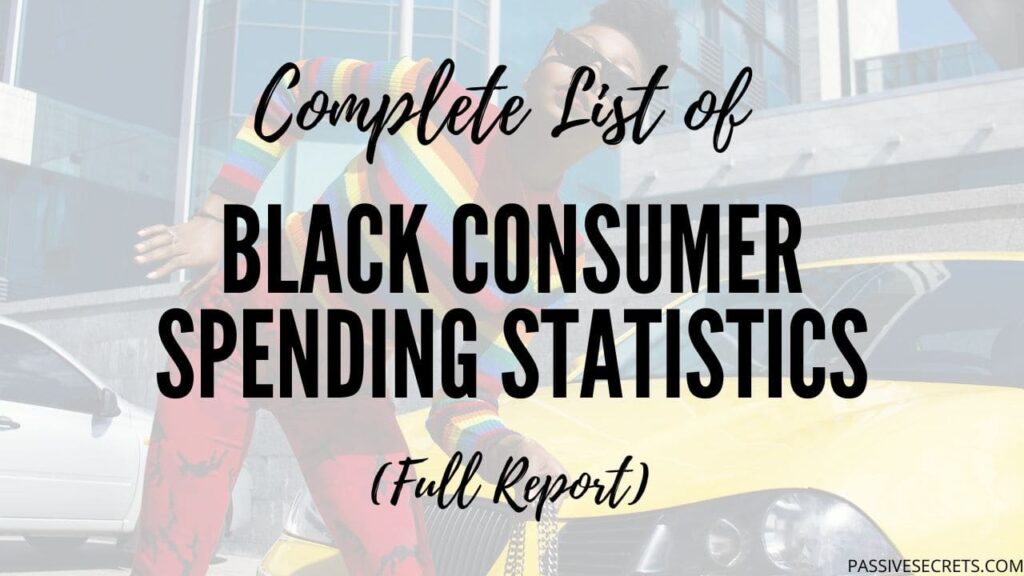
The Black consumer community is one of the fastest-growing yet underrepresented communities in the world.
Blacks are unique, and their buying power is worth trillions of U.S. dollars.
If you want to tap into the Black consumer community, you need to see these powerful statistics.
Yes, I gathered the most recent yet powerful Black consumer spending statistics.
These statistics are eye-opening, revealing what Black consumers really want. It also shows what they spend their money on and their buying capacity.
Key Highlights: Black Consumer Spending Statistics
- The African American purchase power, which is rapidly growing, is expected to reach $1.8 trillion by 2024.
- The wealth of a typical Black family is $44,900.
- Black women and men spend an average of $107.20 and $169.20, respectively, to get ready for dates.
- Black consumer spending grew at a rate of 5% per year, faster than overall US consumer spending growth of 3%.
- 59% of Black respondents said they had been mistreated in stores.
- 25% of Black consumers say they value products that reflect their culture/heritage.
- The top three most purchased categories by Black consumers are salty snacks, soft drinks, and vegetables and herbs categories.
Global Black Consumer Spending Statistics
1. The African American purchase power, which is rapidly growing, is expected to reach $1.8 trillion by 2024. The Black population is expected to grow by 22% between 2020 and 2060, steadily increasing. (source)
2. In 2021, Black Americans possessed a combined buying power of $1.6 trillion. (source)
3. The median income of a Black household is $42,000. (source)

4. Black Americans spend 9x more on ethnic hair and beauty products than the general market. (source)
5. According to Nielsen, Black consumers in the U.S. represent 14% of the population and have nearly $2 trillion in buying power. (source)
6. In the first half of 2022, over 6000 advertisers spent more than $1.2 billion in connecting with Black and African American consumers. (source)
7. There are roughly 3.12 million Black-owned businesses, which generate $206 billion in annual revenue and employ 3.56 million people. (source)
8. In 2022, on average, African American households spent $2,582 for food away from home. (source)
9. The wealth of a typical Black family is $44,900. Unfortunately, it is only 15% of the wealth of a typical White family. (source)
10. Black-owned businesses generated revenue of over $141.1 billion in 2020, an 11% increase since 2017. (source)
11. 14% of Americans are black. 3% of major media ad spending is focused on them. (source)
12. Although 14% of the U.S. population is Black, 37% of those Blacks are Millennials. (source)

13. 41% of Black consumers spend on premium TV services compared to 35% of the general population. (source)
14. Although ad spending is heavily focused on Black men, 44% of Black men felt how they were portrayed in the media was inaccurate. (source)
15. Black/African-American consumers spend an average of 3.5 hours per day watching TV. (source)
16. However, only 38% of Black viewers watch broadcast TV. Additionally, 28% of them said they have difficulty finding things to watch on TV. (source)
17. Only 32% of overall Black viewers feel their representation on TV is accurate. (source)
18. Black consumers’ spending on routine hair care products (shampoo, conditioner, styling) was expected to grow 5.1% in 2023, following similar gains in 2022. (source)
19. In 2019, consumer expenditures by Black households totaled approximately $835 billion, and combined spending by all Black households has increased 5% annually over the past two decades. (source)
20. For Luxury items like watches, Black people account for $60 million of the $385 million in overall spending. (source)
21. Black women spend an average of $107.20 to get ready for dates. However, Black men spend an average of $169.20 to get ready. However, when you include the cost of food, Black women spend $199.90 on average on dates. And Black men spend $268.90. (source)
22. As for women’s fragrances, Black women’s spending represents $151 million of a $679 million industry. (source)
23. Black shoppers accounted for 20% of luxury spending in the U.S. market in 2019, more than ever before. (source)
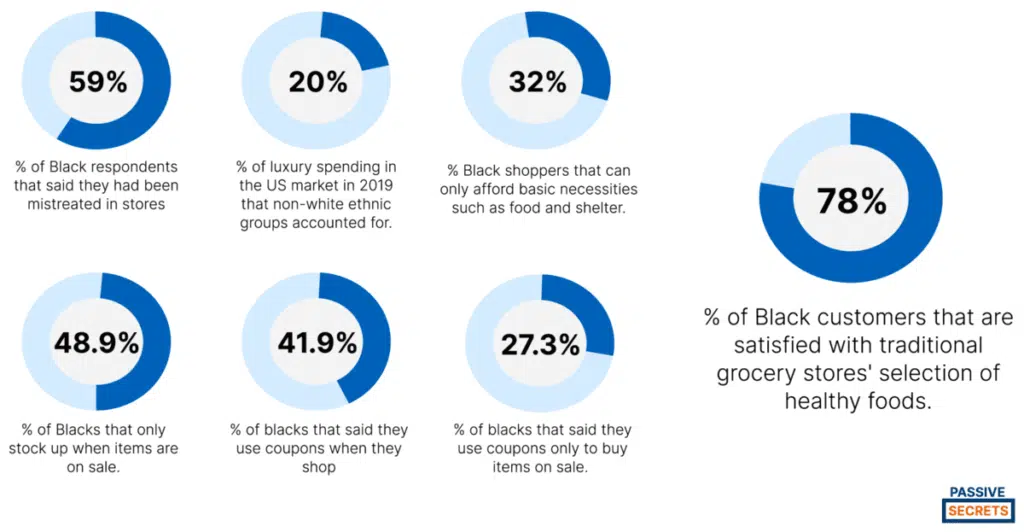
24. Black consumer spending is growing at a rate of 5% per year, faster than overall US consumer spending growth of 3%. (source)
25. In 2019, black households accounted for just under 10% of total national spending on goods and services. (source)
26. Black households, on average, spend approximately $1,900 annually on apparel and related services. (source)
27. Black consumers contribute 11.1% of total beauty spending. (source)
28. Black shoppers are most likely to purchase foods with low sugar. (source)
29. 78% of Black customers are satisfied with traditional grocery stores’ selection of healthy foods. (source)
30. Blacks and Hispanics outspend Whites by 30% on clothing, cars, and jewelry. (source)
31. Black shoppers are concerned about price increases for everyday items. Also, 36% of Black shoppers can only afford basic necessities such as food and shelter. (source)
32. Due to the concerns about inflation, 48.9% of Blacks only stock up when items are on sale. 41.9% say they use coupons when they shop, and 27.3% only buy items on sale. (source)
33. While 76% of Black adults value their ethnicity, only 23% believe Black culture reflects or influences their identity. Also, Black Americans who believe that being Black is important to them are more likely to feel connected to other Black people. (source)
34. 25% of Black consumers say they value products that reflect their culture/heritage. However, 34% say they will value products that are convenient and easy to use. And 31% say they prefer products that promote a healthy lifestyle. (source)
35. Only 33% of Black respondents use mobile banking, and 20% use online banking. (source)
36. Black consumers are known to be highly active on social media platforms, especially Twitter (36.6% of the segment). They have proven that they’re quick to use their platforms to speak on social issues that matter to them. (source)
37. Non-white ethnic groups accounted for about 20% of luxury spending in the US market in 2019. (source)
38. Black consumers are willing to shift approximately $260 billion—about 30% of their current aggregate spending—to companies that can better deliver their needs. (source)
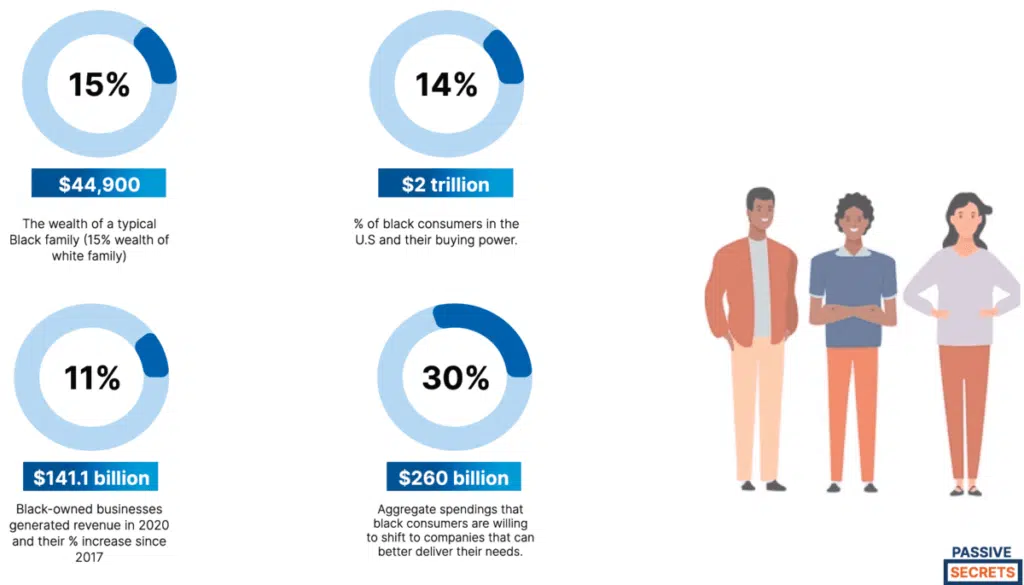
39. Black Consumers will pay up to 1.2 times more on average for offerings better suited to their needs and preferences. (source)
40. Salty snacks are the most purchased category by Black consumers. Soft drinks come in second place. Then, the Vegetables and herbs category comes in third place. (source)
41. However, the least categories of food Blacks are likely to buy are milk, shelf-stable juices and drinks, and fresh sausage. (source)
42. 59% of Black respondents said they had been mistreated in stores. (source)
43. Just 6.3% of marketing research analysts and 5.7% of marketing managers in the United States are Black. (source)
44. At 47.8 million strong, African Americans are the second-largest consumer group, presenting businesses with a $300 billion opportunity stake in this community. (source)
45. Black consumers are tastemakers when setting the tone for mainstream brand choices. (source)
46. Black consumers have a significant influence on spending. (source)
47. 16 million Black Americans live in areas where there are few healthcare providers, which is two and a half times the rate of White Americans. (source)
48. Black consumers are 25% more likely to switch brands. (source)
49. Black consumers also allocatе 28% more spending on children’s itеms annually than other еthnic groups. (source)
50. Black consumers spent $7. 4 billion on diеt and weight loss products and approximately $1.5 billion on grocеriеs. (source)
51. Black-owned networks are more likely to attract Black audiences by over 2.5 times. (source)
52. 19% of Black households account for extremely low-income renters in the U.S. (source)
Black Consumer Spending Behavior on Tech
53. Black Americans are 35% more likely to have 5G Internet at home and 21% more likely to own a 5G-compatible mobile device. They are shifting to 5G Internet for improved reliability, speed, and service bundle options. (source)
54. Black Americans are 32% more likely to have switched ISPs for improved reliability. They are also 23% more likely to have changed ISPs for better service packages. And 34% are more likely to have internet speeds of 1000 Mbps or higher. (source)
55. Black consumers were more likely to watch TV/movies on tablets (26%) and smartphones (43%). Also, 9% more likely to watch TV/movies on CTV. (source)
56. Black Americans are more likely to have protection plans for wearable devices, home gaming consoles, and Internet-connected TVs (69%, 60%, and 50%, respectively). (source)
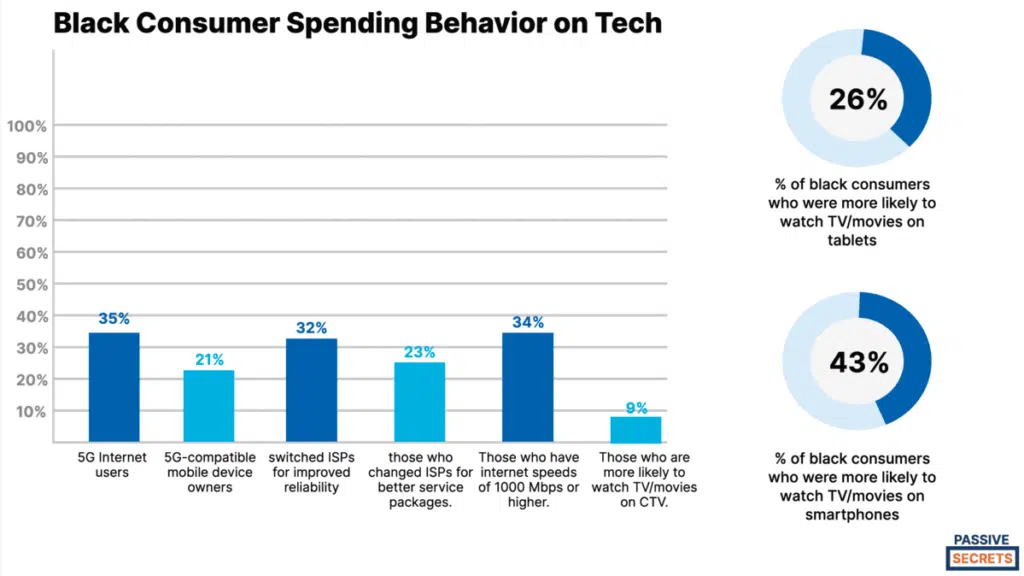
Interesting Facts About Black Consumer Spending
57. The Black community dominates production and consumption in the health, beauty, and wellness industries. (source)
58. The Black community identifies with their culture more than any other race. (source)
Factors Affecting Black Consumer Spending
Black consumers have historically placed importance on brands that resonate with their cultural identity, community engagement, and diversity.
This preference is driven by a combination of factors, including:
1. Underserved Needs
Black consumers have been historically underserved in areas such as food, housing, healthcare, broadband, and banking.
This has led to a significant opportunity for companies to fill these needs and tap into a $300 billion market.
2. Loyalty to Values
Brands that prioritize diversity in their marketing efforts and work to create authentic connections with the Black community are more likely to gain the loyalty of Black consumers.
3. Preference for Black-owned Brands
Black consumers mostly prefer Black-owned fashion brands. These brands are up to 3× more likely to be chosen by Black consumers compared to non-Black consumers
4. Influence of Social Media
Black consumers are highly engaged with social media and other online platforms.
This is how they can directly communicate with brands and demand more inclusive and diverse marketing practices.
5. Social Values
American consumers mostly base their purchasing decisions on their social values.
Hence, brands that support diverse entrepreneurs and speak to Black culture are more likely to gain popularity among both Black and non-Black consumers.
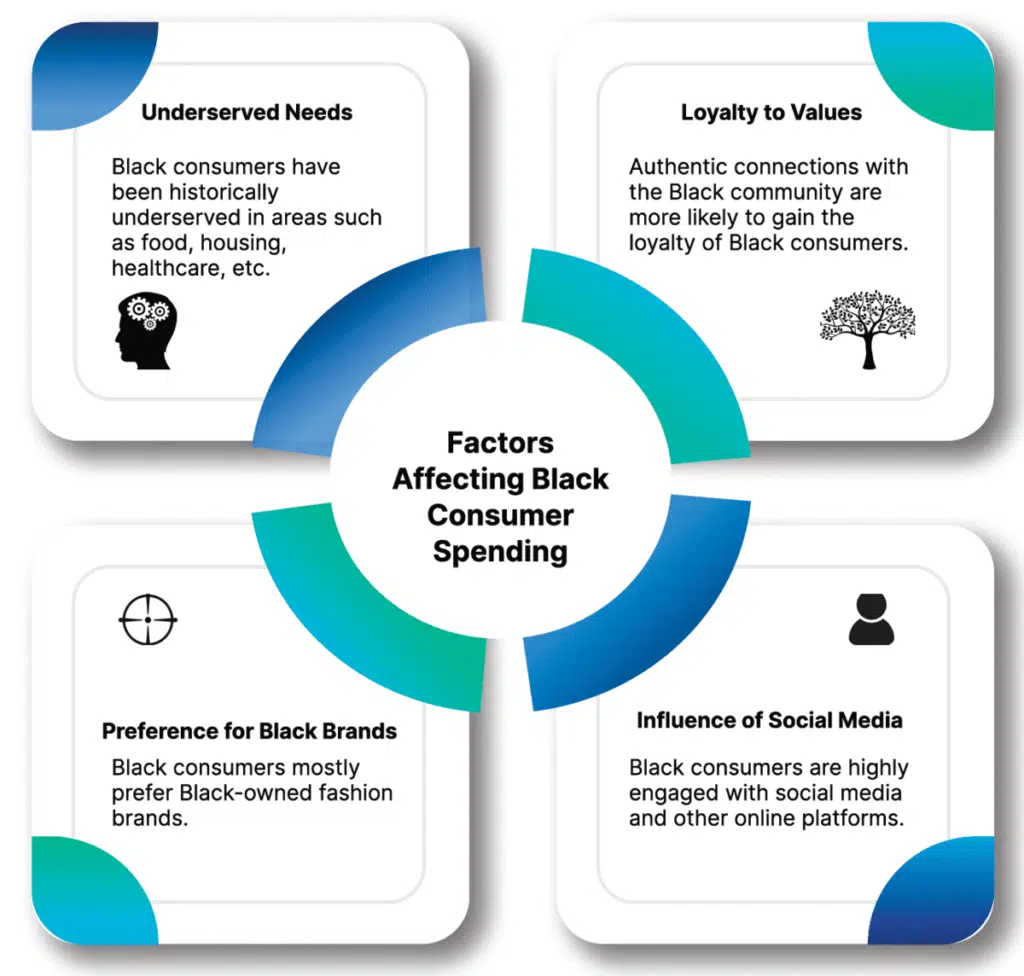
FAQs On Black Consumer Spending
1. What Do Blacks Spend the Most Money On?
Black households spend a significant portion of their income on housing, food, healthcare, and personal care products. According to the U.S. Bureau of Labor Statistics, housing accounted for more than one-third of Black households’ total annual expenditures, followed by transportation and food.
2. What Percentage of Consumers are Black?
Black consumers account for approximately 13.4% of the U.S. population, making them a significant minority group.
3. What is the Black Buying Power?
According to the University of Georgia, Black buying power in the U.S. was estimated to be $1.4 trillion in 2019 and is projected to grow to $1.8 trillion by 2024. Black buying power refers to the total amount of money that Black consumers have available for spending. It is a significant and growing economic force.
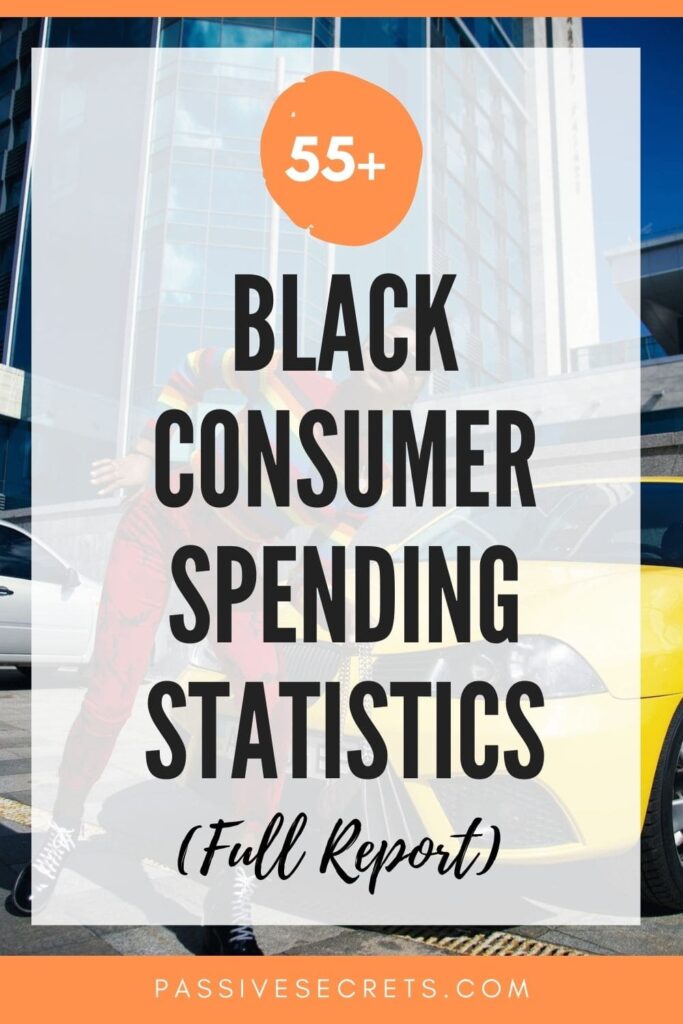
Related Posts:
- 110+ Shocking Income Inequality Data You Need to Know
- Thought-Provoking Gender Inequality Statistics: 160+ Insights Across Regions
- 50 Interesting Sharing Economy Statistics You Need to Know
- 100+ Animation Statistics: The Ultimate Guide To The Industry’s Trends and Insights
- 80+ Franchise Statistics and Facts You Should Know In 2024
- The Future of Learning: 50+ Top EdTech Statistics For 2024
- The Web3 Statistics Report 2024: Trends, Insights, and Predictions
- Meme Statistics 2024: Facts, Trends, and Figures That Will Blow Your Mind
- 85+ MOST Interesting Anime Statistics and Facts (NEW Report)
- Board Game Statistics: Revenue, Market Size, Demographics & More
- 125+ Interesting Airbnb Statistics by Country (Deep Insights)
- 50+ Interesting Born Into Poverty Stay In Poverty Statistics
- 90+ Interesting Film Industry Statistics (NEW Report)
- 80+ Alarming Technology Addiction Statistics You Must Know
- 65+ Impressive Chess Statistics and Facts To Know in 2024
- Spotify Statistics: Latest Report on The Music Streaming Platform
- 50+ Useful Video Game Addiction Statistics, Facts & Huge Trends
- 50+ Vital Internet Safety Statistics & Facts You Must Know
- Internet Dangers Statistics: A Look At The Internet’s Dark Side
- 50 Interesting Bible Statistics and Facts You Didn’t Know
- 95+ Interesting Dream Statistics and Facts You Can’t Miss
- 75+ Interesting Relationship Statistics & Facts You Should Know
- Dance Statistics: A Deep Dive Into The Rhythm Of Movement
- 40+ Incredible Single Father Statistics You Have to Know
- The Battle of the Sexes: Male Vs. Female Spending Statistics
- 95+ Jaw-Dropping Period Poverty Statistics You Need To Know
- 70 Exciting Love Statistics And Facts (True Love, Intimacy, Marriage, Dating & Relationships)
- 30+ Gentle Parenting Statistics & Facts: Is This Parenting Style Worth It?
- Holiday Spending Statistics: Valentine’s Day, Easter, Thanksgiving, & Christmas

